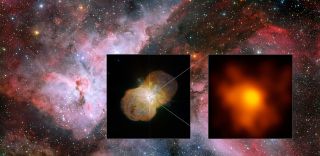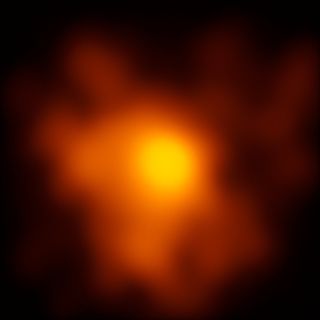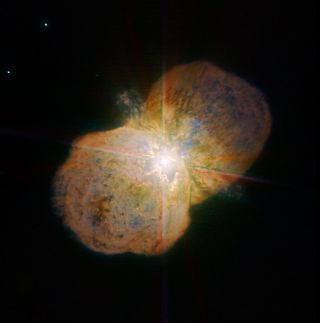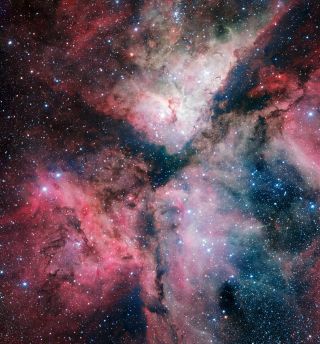Explosive Star System's Turbulent Relationship Revealed in Best View Yet
One of astronomy's most famous stellar pairs sports strange structures in the windy zone between the two stars, according to new observations from the European Southern Observatory's Very Large Telescope Interferometer (VLTI).
Eta Carinae is a star system located about 7,500 light-years from Earth in the constellation Carina. The new images, released today (Oct. 19), provide unprecedented detail of the windy area between the two stars, which could help scientists better understand how massive star evolution works.
ESO researchers created this stunning video of Eta Carinae to zoom into the deepest-ever view of the star system. We weaved telescope imagery and a simulation from ESO, NASA and more and set it to music by The Claypool Lennon Delirium (the tune "There Is No Underwear in Space").

Our dreams came true, because we can now get extremely sharp images in the infrared," said Gerd Weigelt, a scientific member at the Max Planck Institute for Radio Astronomy who led the research. "The VLTI provides us with a unique opportunity to improve our physical understanding of Eta Carinae and many other key objects." [Eta Carinae: An Explosive Star System in HD Images ]
Eta Carinae is known for a great eruption that astronomers observed in the 1830s. Much later, scientists determined the larger star had created the eruption by blowing out lots of dust and gas quickly. The explosion is seen in two lobes around the star system, known as the Homunculus Nebula."

The windy zone between the stars reaches temperatures of reaches extremely high temperatures and is bathed in X-ray radiation, according to the new observations, and it is about 1,000 times smaller than its surrounding nebula. This made the region hard to observe with telescopes either in space or on the ground.

The VLTI team used three of the observatory's four auxiliary telescopes to create an interferometer, which combines the light from multiple telescopes to look at an object in greater detail. The new observations show a fan-shaped structure between the two stars that's created as the smaller star's wind crashes into denser wind from the larger star.
Get the Space.com Newsletter
Breaking space news, the latest updates on rocket launches, skywatching events and more!

Astronomers were also able to measure the velocities of the winds, which will help to create more accurate computer models, the researchers said.
The work was detailed Oct. 19 in the journal Astronomy & Astrophysics.
Follow Elizabeth Howell @howellspace, or Space.com @Spacedotcom. We're also on Facebook and Google+. Original article on Space.com.
Join our Space Forums to keep talking space on the latest missions, night sky and more! And if you have a news tip, correction or comment, let us know at: community@space.com.

Elizabeth Howell (she/her), Ph.D., is a staff writer in the spaceflight channel since 2022 covering diversity, education and gaming as well. She was contributing writer for Space.com for 10 years before joining full-time. Elizabeth's reporting includes multiple exclusives with the White House and Office of the Vice-President of the United States, an exclusive conversation with aspiring space tourist (and NSYNC bassist) Lance Bass, speaking several times with the International Space Station, witnessing five human spaceflight launches on two continents, flying parabolic, working inside a spacesuit, and participating in a simulated Mars mission. Her latest book, "Why Am I Taller?", is co-written with astronaut Dave Williams. Elizabeth holds a Ph.D. and M.Sc. in Space Studies from the University of North Dakota, a Bachelor of Journalism from Canada's Carleton University and a Bachelor of History from Canada's Athabasca University. Elizabeth is also a post-secondary instructor in communications and science at several institutions since 2015; her experience includes developing and teaching an astronomy course at Canada's Algonquin College (with Indigenous content as well) to more than 1,000 students since 2020. Elizabeth first got interested in space after watching the movie Apollo 13 in 1996, and still wants to be an astronaut someday. Mastodon: https://qoto.org/@howellspace
